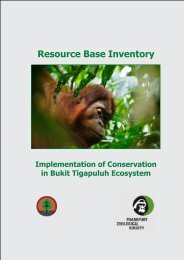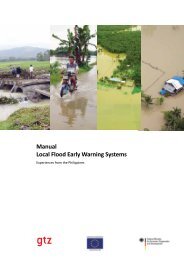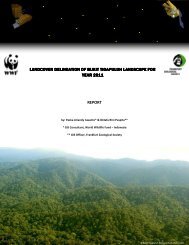The Eastern Himalayas New Species Discoveries
The Eastern Himalayas New Species Discoveries
The Eastern Himalayas New Species Discoveries
Create successful ePaper yourself
Turn your PDF publications into a flip-book with our unique Google optimized e-Paper software.
No mountain range on Earth can match the awe-inspiring <strong>Himalayas</strong>. Home<br />
to all of the world’s highest peaks, many standing above 8,000m, they include<br />
the tallest, the formidable Sagarmatha (Mount Everest) at 8,848m. <strong>The</strong>ir story<br />
is one of fascination and intrigue, which continues to captivate the world.<br />
<strong>The</strong> 3,000km-long Himalayan mountain range, “abode of snow” in Sanskrit, was born from a<br />
massive tectonic collision 40-50 million years ago. <strong>The</strong> energy dissipated by the monumental<br />
meeting of India and Eurasia was far-reaching and shaped many of Asia’s most distinctive<br />
geographical features, including the formation of the Tibetan Plateau; the highest on Earth.<br />
Even today, the relentless movement of the plates continues to push the <strong>Himalayas</strong> further<br />
skyward.<br />
<strong>The</strong> <strong>Eastern</strong> <strong>Himalayas</strong> spanning Bhutan, the north-eastern Indian states of Arunachal<br />
Pradesh, Assam, North Bengal and Sikkim, the far north of Myanmar (Burma), Nepal and<br />
southern reaches of Tibet forms a wall that separates the lowlands of the Indian subcontinent<br />
from the high, dry Tibetan Plateau. Climatic variability and altitudinal gradation have forged<br />
the region into Asia’s land of contrasts, encompassing some of nature’s most magnificent<br />
spaces, from the world’s highest mountains and several of the world’s deepest gorges, to subtropical<br />
jungles, temperate forests, tall grasslands, savannas and rich alpine meadows.<br />
A myriad of cultures and faiths including Buddhists, Hindus, Christians and animists, have<br />
lived closely with the natural environments of the <strong>Eastern</strong> <strong>Himalayas</strong> for millennia. Many of<br />
these communities live in isolation; their customs, lifestyles and livelihoods have been shaped<br />
by their environment, and they remain deeply dependent on the resources nature provides.<br />
Right: <strong>The</strong> beautifullymarked<br />
snow leopard is<br />
also found in the<br />
<strong>Eastern</strong> <strong>Himalayas</strong>.<br />
Where worlds collide<br />
A global biodiversity hotspot 1 , the <strong>Eastern</strong> <strong>Himalayas</strong> is one of the biologically richest areas<br />
on Earth. Because the region sits at the biogeographical crossroads of two continental plates,<br />
it contains an incredible wealth of biodiversity from both worlds. <strong>The</strong> Indo-Malayan Realm<br />
in the lowlands of the <strong>Eastern</strong> <strong>Himalayas</strong> is home to Asian elephants, clouded leopards, wild<br />
water buffalo, gaur, hornbills, cobras and geckos. <strong>The</strong> elevated Palearctic Realm to the north<br />
includes the snow leopard, red pandas, black bears, wolves, and a diverse assemblage of<br />
alpine ungulates, like takins, tahrs and blue sheep.<br />
<strong>The</strong> <strong>Eastern</strong> <strong>Himalayas</strong> hotspot 2 includes four Global 200 ecoregions 3 , critical landscapes of<br />
international biological importance, four World Heritage sites, two Endemic Bird Areas 4 , and<br />
several global centres for plant diversity 5 . <strong>The</strong> <strong>Himalayas</strong> harbour a staggering 10,000 plant<br />
species, from tropical to temperate, 300 mammal species, 977 bird species, 176 reptiles, 105<br />
amphibians and 269 types of freshwater fish 6 . A third of all plants and reptiles are endemic I , as<br />
are 40% of all amphibians 7 .<br />
© Bhutan Times<br />
I<br />
Endemic refers to a species that is exclusively native to a specific place and found nowhere else.<br />
<strong>The</strong> world’s northernmost tropical rainforests can be found in the <strong>Eastern</strong> <strong>Himalayas</strong> 8 and<br />
nearly half of the flowering plants 9 and bird species known from India 10 . <strong>The</strong> plant life of<br />
Arunachal Pradesh is considered among the most diverse in the world, ranking second only to<br />
Sumatra in Indonesia and greater than Borneo, Brazil and Papua <strong>New</strong> Guinea 11 .<br />
Importantly, the region comprises several priority landscapes for the Bengal tiger 12 , Asia’s<br />
largest carnivore, with the densest population of Bengal tigers in the world. <strong>The</strong> forests and<br />
grasslands along the base of the <strong>Eastern</strong> <strong>Himalayas</strong> are also the last bastion for the charismatic<br />
greater one-horned rhino, which once enjoyed a range spanning the entire length of the<br />
Himalaya foothills, from Pakistan to Myanmar 13 but are now restricted to a few corners of<br />
India, Bhutan and Nepal.<br />
People and wildlife form a rich mosaic of life stretching across a remarkable and unparalleled<br />
landscape.<br />
4

















